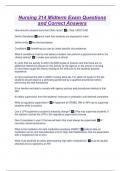Nursing 214 Midterm Exam Questions
and Correct Answers
How should a student document their name? ✅J. Doe, UBCO SN2
Define Standards ✅bench mark that students are expected to meet
Define limits ✅Are the boundaries
Conditions ✅Something you can do under specific circumstances
What 6 conditions must be met before a student can perform a psychomotor skill in the
clinical setting? ✅1) make sure activity is ethical
2) verify that the activity is within the BSN scope of practice and that there are no
additional restrictions placed on this activity by the agency or the school of nursing
3) have been taught the theory relating to the skill prior to the students practice
experience
4) have practiced the skill in UBCO nursing skills lab. For skills not taught in the lab,
students should observe a skill being performed by a qualified practitioner before
performing the skill themselves
5) be familiar and able to comply with agency policies and procedures relating to that
skill
6) obtain supervision from the students' instructor or preceptor until deemed competent
What is regulatory supervision? ✅A registrant of CRNBC (RN or NP) has to supervise
students while in practice
Can a LPN supervise a student's dressing change? ✅LPNs may supervise students, if
the teacher involves the LPN in the regulatory supervision process
Give 2 examples in year 2 that we will learn that must always be supervised ✅IV
narcotics, blood transfusions
What is the institiution for safe medication practices (ISMP)? ✅collects data on
medication errors and has published a list of High Alert Medications that are associated
with a heightened risk of error
What must students do when administering high alert medications? ✅must be double
checked and co-signed by an RN
,ex: anticoagulent (heparin, warfarin), insulin, narcotics, parenteral nutrition solutions,
epidural or intrathecal medications
Name some restricted medications that students are not allowed to administer ✅IV
adrenergic agonists/antagonists, IV antiarrythmics, IV radiocontrast agents,
chemotherapy agents of any kind, neuromuscular blocking agents, cardioplegic agents
IHA list of high alert medications ✅topical : fentanyl patch
SC: chemotherapy, insulin, opioid infusions (ex. fentanyl, hydromorphone, morphine)
IV: chemotherapy, heparin bolus or infusion, insulin bolus or infusion, PCA infusion,
opioid infusion, sodium chloride 3% infusion, magnesium sulfate infusion
epidural: opioid infusions, local anesthetics
When should students perform the 3 checks? ✅1) When removing med from pyxis or
med cart
2) when checking medications prior to medication (this is when independent double
check takes place)
3) @ the bedsite, right before medication administration
Name medication rights ✅right client, time, drug, dose, route, reason, assessment,
client teaching, documentation, evaluation
What are additional rights for parenteral medications ✅right dilution, right
compatability, right rate of administration
What are additional rights for an IV infusion (IV pump, PCA, and epidural)? ✅right
infusion device, right protocol, right program settings
Who can complete an independent double check for students who need to minister an
narcotic? ✅If not clarified than an RN. A registered psychiatric nurse, an LPN, a
physician and a pharmacist can but only if they are delegated by a registrant of the
college
Who can do an independent double check for student that needs to give an insulin
injection? ✅an RN and a registered psychiatric nurse - only if delegated
an LPN, physician and pharmacist CANT
What is a PSLS? ✅A patient safety and learning system. It is documentation or
medication errors or near misses. If one happens, a document must be filled out. Looks
provincially.
Explain where medication errors take place ✅Most commonly in residential care
then medical/acute care
then surgical services (inpatient, anestheasiologist, PAR, perioperative)
, mental health and substance abuse
community- home support
ER services
Lab services
perinatal/child health network
What % of people will need an IV in the acute care setting? ✅Between 60-90%
What does an IV access device allow? ✅Allows the nurse to add something to the
vein, remove something from the vein, and monitor something within the venous system
Explain what might be added to venous system ✅fluids, electrolytes, blood products,
medications, parenteral nutrtrition
Most common are fluid and electrolytes.
albumin, immunoglobins, packed red blood cells = blood products
Explain removing something from the veins ✅blood testing (blood donation = form of
phlebotomy) and phlebotomy which is removing blood from a persons veins
Explain monitoring something in the venous system ✅This allows us to monitor the
venous pressure within the system. It usually is measured in your superior vena cava
and gives healthcare providers a sense of fluid balance and can monitor therapy in
critically ill patients
What does IV therapy include? ✅Peripheral vs central venous access
infusion vs intermittent
long term vs short term
How long is a peripheral line usually in for? ✅3 to 4 days
Explain peripheral veins ✅go into small veins in a persons periphery which will feed
into larger veins and those will feed into larger until reach central venous system
Where are peripheral venous access usually placed in a neonate? ✅around the babies
head
Peripheral lines increase risk of? ✅falling and thrombophlebitis if IV in feed
Central venous access system. Where does it go and who is it oftenly used in? ✅The
IV tip (end of IV catheter) usually threaded up to superior vena cava.
Possible to have some that go into the hearts or pulmonary arteries but avoid as much
as possible -- arrythmias and irritation of heart but may be indicated for severe medical
conditions
Usually used in people with heart conditions to be able to monitor heart function, blood
flow and measure pressure in pulmonary arteries




